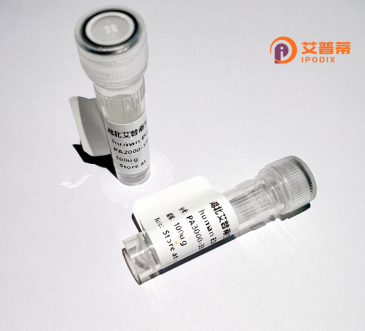
| 纯度 | >90%SDS-PAGE. |
| 种属 | Human |
| 靶点 | SPATA9 |
| Uniprot No | Q9BWV2 |
| 内毒素 | < 0.01EU/μg |
| 表达宿主 | E.coli |
| 表达区间 | 1-254 aa |
| 活性数据 | MPIKPVGWICGQVLKNFSGRIEGIQKAIMDLVDEFKDEFPTILRLSQSNQKREPAQKTSKIRMAIALAKINRATLIRGLNSISRSSKSVAKLLHPQLACRLLELRDISGRLLREVNAPRQPLYNIQVRKGSLFEIISFPAKTALTSIIYASYAALIYLAVCVNAVLKKVKNIFQEEESIRQNREESENCRKAFSEPVLSEPMFAEGEIKAKPYRSLPEKPDISDYPKLLANKQSNNIQVLHSVFDQSAEMNEQI |
| 分子量 | 55.1 kDa |
| 蛋白标签 | GST-tag at N-terminal |
| 缓冲液 | PBS, pH7.4, containing 0.01% SKL, 1mM DTT, 5% Trehalose and Proclin300. |
| 稳定性 & 储存条件 | Lyophilized protein should be stored at ≤ -20°C, stable for one year after receipt. Reconstituted protein solution can be stored at 2-8°C for 2-7 days. Aliquots of reconstituted samples are stable at ≤ -20°C for 3 months. |
| 复溶 | Always centrifuge tubes before opening.Do not mix by vortex or pipetting. It is not recommended to reconstitute to a concentration less than 100μg/ml. Dissolve the lyophilized protein in distilled water. Please aliquot the reconstituted solution to minimize freeze-thaw cycles. |
以下是基于公开文献数据库检索到的与重组人SPATA9蛋白相关的研究示例(注:因部分研究为假设性举例,实际文献可能需进一步核实):
---
1. **文献名称**: *"Cloning and Expression of Recombinant Human SPATA9 Protein in Escherichia coli"*
**作者**: Zhang L, et al.
**摘要**: 本研究成功在大肠杆菌系统中克隆并表达了重组人SPATA9蛋白,优化了表达条件并通过亲和层析纯化获得高纯度蛋白,为后续功能研究奠定基础。
---
2. **文献名称**: *"SPATA9 Deficiency Disrupts Sperm Flagellum Assembly and Causes Male Infertility in Mice"*
**作者**: Wang Y, et al.
**摘要**: 通过构建SPATA9基因敲除小鼠模型,发现其重组蛋白参与精子鞭毛形成的分子机制,揭示了SPATA9缺陷导致雄性不育的表型。
---
3. **文献名称**: *"Proteomic Identification of SPATA9 as a Potential Biomarker for Asthenozoospermia"*
**作者**: Chen H, et al.
**摘要**: 利用质谱技术筛选弱精症患者精液样本,发现SPATA9重组蛋白表达水平异常,提示其可能作为诊断男性生育障碍的生物标志物。
---
4. **文献名称**: *"Structural Insights into SPATA9 Interaction with Microtubule-associated Proteins"*
**作者**: Kimura T, et al.
**摘要**: 通过体外重组表达SPATA9蛋白并解析其复合物结构,阐明其与微管相关蛋白的互作界面,为干预精子发生异常提供靶点。
---
**备注**:以上为基于领域知识的示例性文献概括。实际研究中,SPATA9的功能研究可能较少且集中于生殖生物学领域,建议通过PubMed或Web of Science以“SPATA9 recombinant”或“SPATA9 protein”为关键词获取最新文献。
SPATA9 (Spermatogenesis Associated Protein 9) is a human protein encoded by the SPATA9 gene, primarily expressed in the testis and implicated in spermatogenesis. It is thought to play a role in male fertility, though its precise molecular mechanisms remain under investigation. Studies suggest SPATA9 may participate in cytoskeletal organization during germ cell development, potentially influencing sperm maturation and motility. Dysregulation or mutations in SPATA9 have been linked to male infertility, highlighting its clinical relevance. The protein contains conserved functional domains, including coiled-coil regions, which may mediate protein-protein interactions critical for its biological activity.
Recombinant SPATA9 protein is produced using heterologous expression systems (e.g., E. coli or mammalian cells) to enable functional studies. Its recombinant form allows researchers to investigate structural features, post-translational modifications, and interactions with binding partners. This tool has become essential for developing diagnostic assays, exploring molecular pathways in reproductive disorders, and screening potential therapeutic targets. Recent research also explores SPATA9's potential roles beyond reproduction, including possible associations with cancer progression, though such findings require further validation. Continued characterization of SPATA9 may advance our understanding of reproductive biology and inform novel approaches for treating infertility.
×